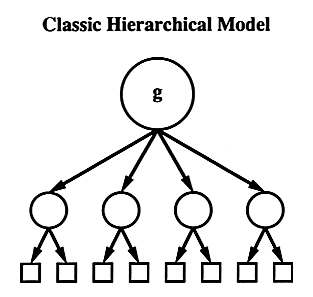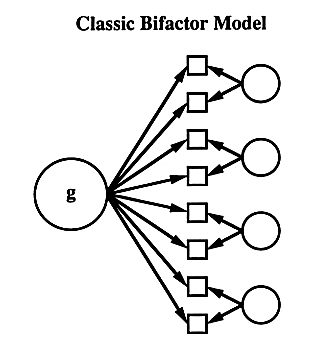



Two different structural models of intelligence can be distinguished, the hierarchical model and the bifactor model. In a structural model, squares represent observables (such as specific tests, or the specific items of which a test is comprised), and circles represent unobservables (factors, the hypothetical entities that explain the correlations among the observables). The arrows represent the correlations of the tests with the factors; such correlations are known as factor loadings.
The hierarchical model is more efficient because it uses fewer parameters than the bifactor model. Counting arrows (parameters) in the figures above will reveal that the hierarchical model uses twelve parameters, and the bifactor model uses sixteen. Thus, the hierarchical model is more efficient.
However, the bifactor model allows one to talk about independent components or independent factors. The factors in the bifactor model (but not in the hierarchical model) are pure, uncorrelated, non-redundant. One would rather include independent factors in a regression equation than non-independent factors.
An example of the hierarchical model of intelligence is a model in which verbal and spatial abilities correlate r = .6. An example of the bifactor model of intelligence is a model in which verbal and spatial abilities do not correlate (i.e., they are orthogonal). Of course, this empirical difference in verbal and spatial abilities in a hierarchical model and a bifactor model would require that verbal and spatial abilities also differ conceptually between the two models.
Beyond the question of structure lies the deeper question, what is the meaning in terms of understandability or theoretical utility of these different models? If g is brain size, and everything else is an independent cognitive module, then the bifactor model makes sense. If g is the common variance of verbal and spatial abilities, then a hierarchical model is better.
Last modified January 1999
Visited times since July 2001
Comments?
Home to Intelligence
Home to Great Ideas in Personality